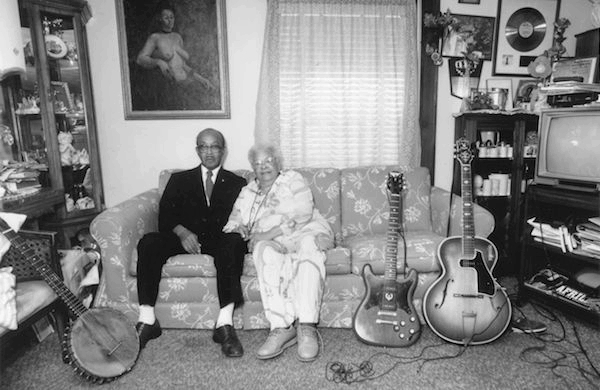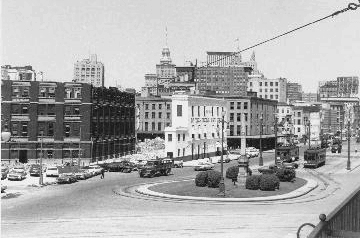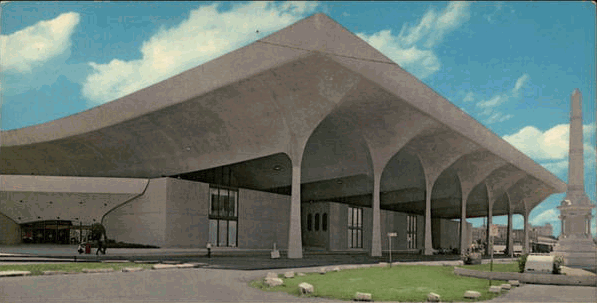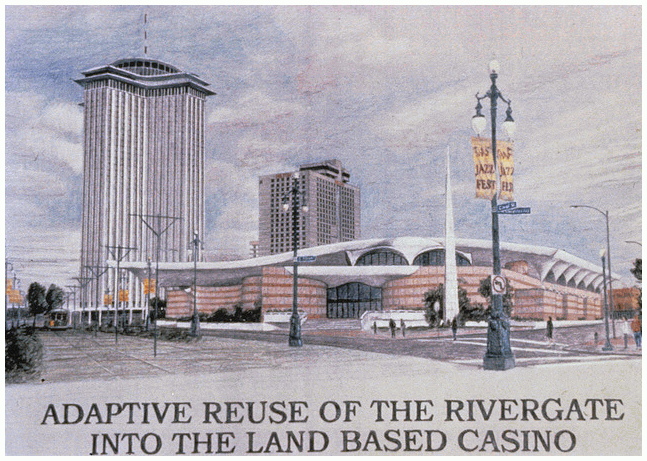|
Today in New Orleans History |
|
|
January 13


 Danny Barker is Born in New
Orleans Birthplace of Danny Barker January
13, 1909 African-America Creole guitar and banjo player, songwriter, composer, singer, author,
historian, teacher, storyteller, humorist, actor, painter. Jazz Hall of Fame member. Recipient of the National
Endowment of the Arts Music Master Award and numerous other honors. Played on more than 1,000 records of Jazz, Swing,
Blues, Bebop, and Traditional. Husband of legendary singer Blue Lu Barker. Daniel "Danny"
Moses Barker was born on January 13, 1909, in New Orleans. Born into a musical family, his interest in jazz
came early. His grandfather, Isidore Barbarin, had been a member of the great Onward Brass Band. Clarinetist Barney Bigard,
who played with Duke Ellington, gave Danny lessons in clarinet. His uncle, the great jazz drummer Paul Barbarin, also taught
him how to play the drums. Nonetheless, when it came to playing music, Danny settled on the banjo and guitar as his favorite
instruments. In 1930, he married Louise Dupont, who sang blues and was better known as "Blue
Lu" Barker. The couple moved to New York that year where he led the life of a jazz musician; working the clubs and
doing session work. While there, he worked with great musicians like Red Allen, Sidney Bechet and the legendary "Jelly
Roll" Morton . In 1938, he recorded with Decca Records. Along with his wife Blue Lu, he wrote
her best known hit, "Don't You Feel My Leg" a risqué tune recorded as "Don't You Make Me High".
Also in that year, he joined Benny Carter's Big Band. The following year, he became rhythm guitarist for Cab Calloway's Big
Band and played and recorded with Calloway until the late 1940s. Following his break with Calloway, he became a freelance
rhythm man recording in New York with other great New Orleans transplants such as Sidney Bechet.
By the mid 1960's, he and his wife decided to return to New Orleans and keep the traditions associated with jazz music
alive by lecturing on traditional jazz history. He founded the Fairview Baptist Church Band to continue the marching band
tradition. Young musicians like trumpeter and composer Wynton Marsalis and drummer Herlin Riley were members of the Fairview
band. Barker continued performing and sharing his love and knowledge of jazz music until his death on March 13, 1994
[at the age of 85]. (From the New Orleans Public Library) Photograph by Syndey Byrd.
 

To receive an update for each day in New Orleans history,
join our facebook page - Today in New
Orleans History
Born in New Orleans on October 30, 1884 Fannie Heaslip Lea, daughter of James J.
Lea and Margaret Heaslip attended public schools, graduated from H. Sophie Newcomb Memorial College with a B.A.
in 1904, and did graduate work in English at Tulane. Until her marriage in 1911, she wrote feature articles
for New Orleans daily newspapers and short stories for magazines such as Harper's, a short
story, Little Anna and the Gentleman Adventurer, in the 1910 The Century Magazine and Woman's Home Companion. After
moving to Honolulu with here husband Hamilton Pope Agee, her first novel Quicksands, was
published.S he divorced in 1926 and moved to New York, publishing 19 novels and more than 100 stories, poems, and essays
in various newspapers and journals, until her death on January 13 1955. Lea wrote several plays. Her
first, Round-About, was produced in 1929 by the New York Theatre Assembly. Her papers are
housed in the University of Oregon Library in Eugene, Oregon.
Nicolas-Ignace de Beaubois (October 15, 1689 – January 13, 1770) was a French
Jesuit priest and missionary who joined the Canadian mission in Quebec in 1719. Beaubois spent a training period in Quebec
and began his spreading of religious doctrine among the Illinois Indians in 1721. On 2 Feb.
1723, at Kaskaskia, Illinois he took the vows of a Jesuit. Because of the expansion of the Mississippi valley missions, the
Jesuits had made the area a distinct mission district within the diocese of Quebec and Beaubois became the superior. He immediately
went to France to populate and strengthen the new jurisdiction. The Compagnie des Indes was responsible for funding
the parishes and missions in the Missio Ludovisiana district and he was successful in negotiating appropriate funding
for future operations. He obtained authorization for the Jesuits to open a house in New Orleans and to have a plantation
near the city for supplementing their operation. Beaubois also arranged to have Ursuline nuns funded to establish a girls’
school in New Orleans. This became the first girls' school in the Mississippi valley. It was under construction from 1964 to 1968,
at a cost of $25 million. By 1994, this building was estimated to be worth $300 million. The Rivergate had pedestrian
entrances on Canal and Poydras Streets and Convention Center Boulevard. The South Peters Street elevation was dedicated
to entrance and exit openings for the two-level subsurface 800-automobile parking garage, a long loading dock with two
access doors 20' x 20' to the first floor, and freight elevators. The caption for the postcard (above) reads: The
RIVERGATE, which covers six city squares, located where famed Canal Street meets the Mississippi River, is one of the most
uniquely constructed convention-exhibition halls in the country. Boasting 130,000 square feet of clear, unobstructed space,
with no posts or pillars; it is capable of seating more than 16,000 persons for an assembly or meeting with 733 - 10'
x 10' exhibit spaces, or a combination of both. This 13 1/2 million dollar ($13,500,000) structure will be one of the
nation's newest and finest facilities". Ground breaking ceremonies on December 4, 1964 were followed
by the driving of piles and a deep excavation to provide space for the parking garage, mechanical and electrical equipment,
stairs and escalators to move people from subsurface levels up to the first floor, and the tunnel 60' x 750' ($1.3
million). Although the Rivergate was conceived and designed as a convention-exhibition facility, it was also used
as the venue for Mardi Gras balls, high school graduations, and the lying in state of New Orleans native Mahalia Jackson
in 1972). But like the Municipal Auditorium, the Rivergate became obsolete in its usefulness as a convention and exhibition
center. The Ernest N. Morial Convention Center was being planned in 1978. As of 2006, it has about 1.1
million square feet of exhibit space, covering almost 11 blocks, and over 3 million square feet of total space. It
is the 5th-largest facility of its kind in the United States and would dwarf the old Rivergate. The
City of New Orleans then altered the zoning ordinances to allow construction of a casino at the Rivergate site.
The city issued a call for casino proposals due on August 14, 1992 which required a $50,000 payment for the privilege
of submitting a proposal, half of which was refundable to unsuccessful bidders. On November 5, 1992, Mayor
Sidney Barthelemy and the City Council picked Christopher Hemmeter-Caesar's Palace (known as the Grand Palais group) to lease
the city-owned Rivergate site for development of a casino. The lease was signed on April 27, 1993. Subsequently,
the Casino Board awarded the casino operator's license to Harrah's Jazz, a partnership of Harrah's and the Jazzville group
(all local investors). On April 15, 1993, Mayor Barthelemy and the City Council finalized the selection of
Hemmeter as the "developer" -- he later teamed with Caesar's World of Las Vegas to operate the casino in a renovated
Rivergate but soon the Hemmeter-Caesar's group proposed its demolishion to make way for a new building called Grand Palais.
This plan would include a twenty-two-inch deep pond, called Celebration Lake which would run across the foot of Canal
Street, ending at One Canal Place. And there would be a sound and laser-light show and much more including a recreation
of Bernard the colonnaded arcades at the Palace of Fine Arts in San Francisco. In the end, the only elements of the
Grand Palais scheme that were constructed were the "Casino Support Facility" -- a ten-leve, 2 1/2 block long
parking garage) which replaced a group of nineteenth-century buildings at the corner of Poydras and South Peters Streets
and the tunnel linking it to the casino. But everything else fell through. The official "wall-breaking"
ceremony took place on Friday, January 13, 1995. On this occasion, a back hoe equipped with a claw toothed bucket and
a "Harrah's" banner draped on its back climbed up the steps at the Canal-South Peters Streets entrance and began
wrecking the underside of the cement plaster entrance canopy. Much of the concrete debris was hauled to West
End at Lake Pontchartrain to be used as fill for enlargement of a park off Breakwater Drive. Although only reinforced
concrete was supposed to be dumped there, other debris was included. The nature of the debris stirred environmentalists
and their protests stopped the dumping at the West End site. On October 28, 1999, Harrah's Casino was completed
at the foot of Canal Street, three years behind schedule. From THE RIVERGATE (1968 - 1995) Architecture And Politics -- No Strangers In Pair-A-Dice |
|
|

To receive an update for each day in New Orleans history,
join our facebook page - Today in New
Orleans History.
Analytics |
 A plaque is affixed on the exterior wall of the brick two-story wrought iron-clad building at 1027 Chartres Street between
St. Philip Street and Ursulines Avenue. It reads:
A plaque is affixed on the exterior wall of the brick two-story wrought iron-clad building at 1027 Chartres Street between
St. Philip Street and Ursulines Avenue. It reads:
 The Rivergate was designed by the local firm Curtis and Davis (Nathaniel Cortlandt Curtis Jr. (1917–1997) and Arthur
Quentin Davis (1920–2011) who had also designed the Thomy Lafon School (1954) and the Louisiana State Penitentiary
at Angola (1956) and would later design the Superdome. The undulating forms of the Rivergate's thin barrel
vaults were not whimsical but are the precise shape necessary to manage the unusually long spans required for the roof
over the column free space below. The cantilevers all around contribute to the stability of the roof structure. The selection
of six temple like bays utilized to the limit the spans between columns; the columns themselves are slender and graceful,
suited to the task of support. The Rivergate, while it stood in New Orleans, was looked upon by many as a significant
example of outstanding national and international contemporary architecture and was compared to the recognized masterpieces
of its period. The most distinguishing feature of the Rivergate was the roof. The 95,500-sq. foot South Hall
was covered by a swooping and sweeping dual curved roof. This reinforced concrete barrel-arched roof design was symbolic
of the rolling Mississippi River which flows about 500 feet from the building. Engineering News Record referred to
these "humpbacked" 1-1/2 catenary curve barrel arches 453 ft. long as having the profile of a whale. The Rivergate
roof was perhaps the longest thin shell concrete roof span that had been constructed at that time. The 34,500-sq. foot
North Hall, later called Penn Hall, in honor of its distinguished and successful manager, Herman Penn, was spanned
by steel trusses 6' deep and covered with a flat roof.
The Rivergate was designed by the local firm Curtis and Davis (Nathaniel Cortlandt Curtis Jr. (1917–1997) and Arthur
Quentin Davis (1920–2011) who had also designed the Thomy Lafon School (1954) and the Louisiana State Penitentiary
at Angola (1956) and would later design the Superdome. The undulating forms of the Rivergate's thin barrel
vaults were not whimsical but are the precise shape necessary to manage the unusually long spans required for the roof
over the column free space below. The cantilevers all around contribute to the stability of the roof structure. The selection
of six temple like bays utilized to the limit the spans between columns; the columns themselves are slender and graceful,
suited to the task of support. The Rivergate, while it stood in New Orleans, was looked upon by many as a significant
example of outstanding national and international contemporary architecture and was compared to the recognized masterpieces
of its period. The most distinguishing feature of the Rivergate was the roof. The 95,500-sq. foot South Hall
was covered by a swooping and sweeping dual curved roof. This reinforced concrete barrel-arched roof design was symbolic
of the rolling Mississippi River which flows about 500 feet from the building. Engineering News Record referred to
these "humpbacked" 1-1/2 catenary curve barrel arches 453 ft. long as having the profile of a whale. The Rivergate
roof was perhaps the longest thin shell concrete roof span that had been constructed at that time. The 34,500-sq. foot
North Hall, later called Penn Hall, in honor of its distinguished and successful manager, Herman Penn, was spanned
by steel trusses 6' deep and covered with a flat roof.  In June 1992, Louisiana House Bill 2010 (Act 384 of the 1992 Regular Session) authorized a land-based casino in New Orleans.
The legislation specifically defined the location of the land-based casino -- the Rivergate site at the foot of Canal
Street. The law did not require the Rivergate to be torn down, and it did not require a new casino to be built.
In June 1992, Louisiana House Bill 2010 (Act 384 of the 1992 Regular Session) authorized a land-based casino in New Orleans.
The legislation specifically defined the location of the land-based casino -- the Rivergate site at the foot of Canal
Street. The law did not require the Rivergate to be torn down, and it did not require a new casino to be built.
